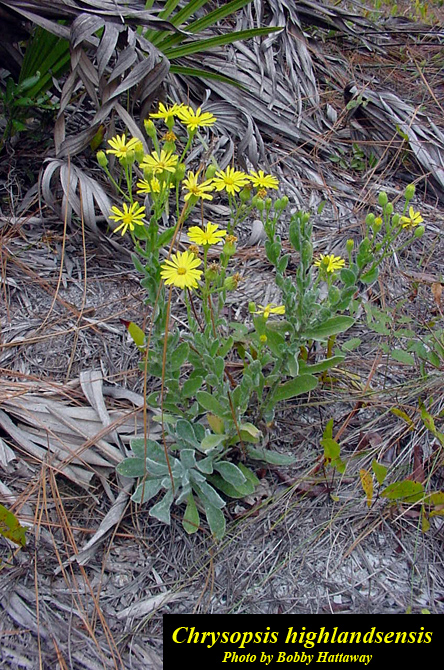Difference between revisions of "Chrysopsis highlandsensis"
KatieMccoy (talk | contribs) |
|||
| Line 19: | Line 19: | ||
Common name: Highlands goldenaster | Common name: Highlands goldenaster | ||
| − | ==Taxonomic notes== | + | <!--==Taxonomic notes==--> |
==Description== | ==Description== | ||
<!-- Basic life history facts such as annual/perrenial, monoecious/dioecious, root morphology, seed type, etc. --> | <!-- Basic life history facts such as annual/perrenial, monoecious/dioecious, root morphology, seed type, etc. --> | ||
| Line 40: | Line 40: | ||
===Seed bank and germination=== | ===Seed bank and germination=== | ||
It has been found to divide by rhizomes, tubers, corms, and bulbs <ref name="Dave">[[http://davesgarden.com/guides/pf/go/90520 Dave's Garden]]Accessed: December 4, 2015</ref>. It has been observed to produce a limited persistent soil seed bank <ref name="Archbold"/>. | It has been found to divide by rhizomes, tubers, corms, and bulbs <ref name="Dave">[[http://davesgarden.com/guides/pf/go/90520 Dave's Garden]]Accessed: December 4, 2015</ref>. It has been observed to produce a limited persistent soil seed bank <ref name="Archbold"/>. | ||
| − | + | <!--===Fire ecology===--> <!--Fire tolerance, fire dependence, adaptive fire responses--> | |
| − | ===Fire ecology=== <!--Fire tolerance, fire dependence, adaptive fire responses--> | + | <!--===Pollination===--> |
| − | + | <!--===Use by animals===--> <!--Herbivory, granivory, insect hosting, etc.--> | |
| − | ===Pollination=== | + | <!--===Diseases and parasites===--> |
| − | ===Use by animals=== <!--Herbivory, granivory, insect hosting, etc.--> | ||
| − | ===Diseases and parasites=== | ||
==Conservation and Management== | ==Conservation and Management== | ||
Global Conservation Status: G2 <ref name="Natureserve">[[http://explorer.natureserve.org/servlet/NatureServe?searchName=Chrysopsis+highlandsensis NatureServe]]Accessed: December 4, 2015</ref>. | Global Conservation Status: G2 <ref name="Natureserve">[[http://explorer.natureserve.org/servlet/NatureServe?searchName=Chrysopsis+highlandsensis NatureServe]]Accessed: December 4, 2015</ref>. | ||
| − | + | <!--==Cultivation and restoration==--> | |
| − | ==Cultivation and restoration== | ||
==Photo Gallery== | ==Photo Gallery== | ||
==References and notes== | ==References and notes== | ||
Revision as of 18:59, 19 January 2016
| Chrysopsis highlandsensis | |
|---|---|

| |
| Photo by Bobby Hattaway, Atlas of Florida Vascular Plants | |
| Scientific classification | |
| Kingdom: | Plantae |
| Division: | Magnoliophyta - Flowering plants |
| Class: | Magnoliopsida – Dicotyledons |
| Order: | Asterales |
| Family: | Asteraceae ⁄ Compositae |
| Genus: | Chrysopsis |
| Species: | C. highlandsensis |
| Binomial name | |
| Chrysopsis highlandsensis DeLaney & Wunderlin | |
Error creating thumbnail: Unable to save thumbnail to destination
| |
| Natural range of Chrysopsis highlandsensis from USDA NRCS Plants Database. | |
Common name: Highlands goldenaster
Contents
Description
C. highlandsensis is a perennial species with a short taproot and a basal rosette that shoots up a lanate flowering stem [1].
Distribution
It is endemic to central peninsular Florida (Weakley 2015).
Ecology
Habitat
C. highlandsensis is endemic to the Lake Wales Ridge and is found in sandpine scrubs, scrubby flatwoods, and turkey oak/longleaf communities[1][2]. It has been found in historically and chronically disturbed habitats [2] and has observed to have a high survival rate after hurricanes (Menges et al. 2011). Associated species include Lechea cernua, Polygonella basiramia, Selaginella arenicola, and Liatris tenuifolia[2].
Phenology
It is a semelparous species, usually flowering the third year of life. Yellow composite flowers appear November and December [1].
Seed dispersal
The fruit is a composite achene with a pappus modified for wind dispersal [1].
Seed bank and germination
It has been found to divide by rhizomes, tubers, corms, and bulbs [3]. It has been observed to produce a limited persistent soil seed bank [1].
Conservation and Management
Global Conservation Status: G2 [4].
Photo Gallery
References and notes
Menges, E. S., C. W. Weekley, et al. (2011). "Effects of Hurricanes on Rare Plant Demography in Fire-Controlled Ecosystems." Biotropica 43(4): 450-458.
Weakley, Alan S. Flora of the Southern and Mid-Atlantic States: Working Draft of 21 May 2015. University of North Carolina Herbarium (NCU). PDF. 1102.
- ↑ 1.0 1.1 1.2 1.3 1.4 [Archbold Biological Station]Accessed: December 4, 2015
- ↑ 2.0 2.1 2.2 [University of Florida Herbarium]Accessed: December 4, 2015
- ↑ [Dave's Garden]Accessed: December 4, 2015
- ↑ [NatureServe]Accessed: December 4, 2015